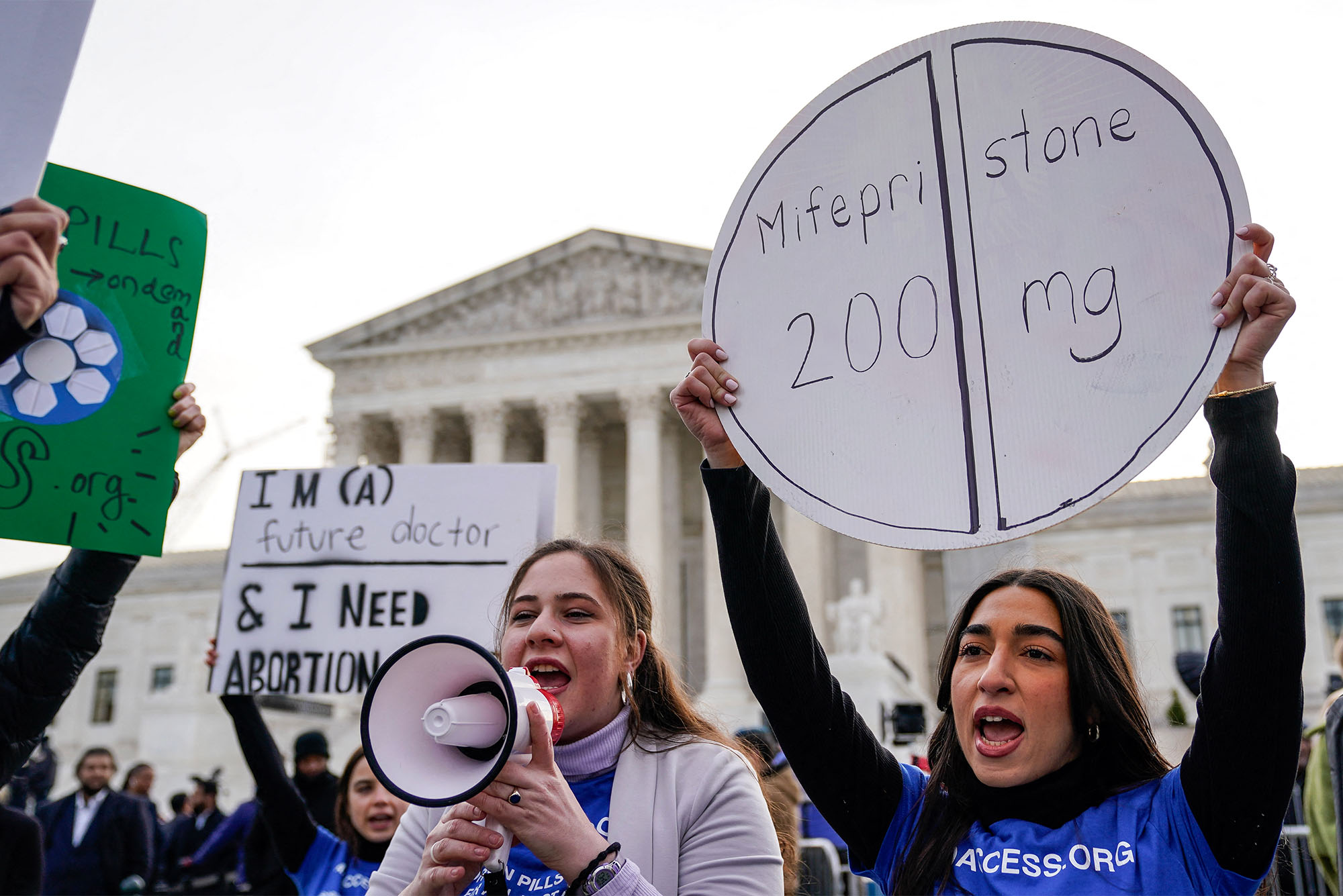Supreme Court Upholds Access to Abortion Pill Mifepristone
Unanimous decision leaves FDA’s approval of a widely used abortion pill intact, but sidesteps bigger questions about the future of abortion access in the United States, says LAW’s Nicole Huberfeld

In their ruling, the Supreme Court justices sided with the Biden administration and the makers of mifepristone, reversing a lower court decision that would have made it more difficult to obtain the drug used in more than 60 percent of US abortions. Photo by Drew Angerer/AFP via Getty Images
Supreme Court Upholds Access to Abortion Pill Mifepristone
Unanimous decision leaves FDA’s approval of a widely used abortion pill intact, but sidesteps bigger questions about the future of abortion access in the United States, says LAW’s Nicole Huberfeld
The Supreme Court upheld access to a widely used abortion pill, mifepristone, in a unanimous decision issued on Thursday. The opinion, written by Justice Brett M. Kavanaugh, rejects a bid by a group of antiabortion doctors to unravel the US Food and Drug Administration’s approval of the pill, holding instead that the group didn’t have the legal standing to bring the case in the first place.
The decision to sidestep the substance of the arguments and instead make a procedural ruling on standing “isn’t a surprise,” says Nicole Huberfeld, the Edward R. Utley Professor of Health Law, Bioethics & Human Rights at the BU School of Public Health and a School of Law professor of law.
“It would have been a miscarriage of justice for the court to decide the substance of this case,” she says. “But this [decision] doesn’t mean that this kind of question couldn’t come to federal courts again—with the right parties.”
In their ruling, the justices sided with the Biden administration and the makers of mifepristone, reversing a lower court decision that would have made it more difficult to obtain the drug used in more than 60 percent of US abortions.
The plaintiffs in this case are members of an umbrella group of antiabortion doctors and antiabortion organizations. They challenged the FDA’s long-standing approval of mifepristone, which is the first in a two-drug protocol for medical abortion. (The other is misoprostol.) Their argument stems largely from two changes the FDA made in 2016 and 2021, both making it easier to access the pill through telemedicine and by mail. The groups also questioned the safety of mifepristone—questions that fly in the face of the drug’s well-established scientific record of safety.

“I think it’s important for people to recognize that mifepristone remains legal, and it remains legal under the 2021 protocols that make it permissible to obtain mifepristone via telehealth—you don’t have to see a physician in person,” Huberfeld says.
The court’s ruling is a lukewarm victory for abortion rights advocates, as it merely maintains the status quo—14 US states still have near-total abortion bans in place—and doesn’t prevent another antiabortion plaintiff from trying a similar case in the future.
The Supreme Court justices found that the antiabortion groups in this case lacked standing, or the legal ground, to bring the suit at all. To establish standing, a plaintiff must demonstrate that they have suffered or likely will suffer an injury, that the injury likely was caused or will be caused by the defendant, and that the injury likely would be redressed by the requested judicial relief.
Quoting the late Justice Antonin Scalia, Kavanaugh distilled the issue of standing down to a single question: “‘What’s it to you?’”
“We recognize that many citizens, including the plaintiff doctors here, have sincere concerns about and objections to others using mifepristone and obtaining abortions,” Kavanaugh wrote in the unanimous opinion. “But citizens and doctors do not have standing to sue simply because others are allowed to engage in certain activities—at least without the plaintiffs demonstrating how they would be injured by the government’s alleged underregulation of others.”
When it overturned Roe v. Wade in 2022, the Supreme Court signaled it was getting out of the abortion business, and instead turning those decisions over to Congress and to the individual states.
“The plaintiffs may present their concerns and objections to the President and FDA in the regulatory process, or to Congress and the President in the legislative process,” Kavanaugh wrote. “And they may also express their views about abortion and mifepristone to fellow citizens, including in the political and electoral processes.”
Huberfeld says it was always probably a fantasy that the high court could get out of ruling on abortion policy issues. Even now, the court is poised to issue another major abortion decision in the coming weeks, this time about whether hospital emergency rooms are required to provide abortions in urgent situations, such as if a woman’s life is in jeopardy.
“There is so much conflict between state laws on abortion and related intimate matters,” Huberfeld says, adding, for example, that many of the challenges to gender-affirming care follow the same playbook as antiabortion cases. “I think we’re just going to see more conflict, not less. And there really is no way that the Supreme Court cannot get involved in that. So, my take is that the court is going to continue to hear cases, and maybe hear more abortion cases than it has in the past.”
Comments & Discussion
Boston University moderates comments to facilitate an informed, substantive, civil conversation. Abusive, profane, self-promotional, misleading, incoherent or off-topic comments will be rejected. Moderators are staffed during regular business hours (EST) and can only accept comments written in English. Statistics or facts must include a citation or a link to the citation.